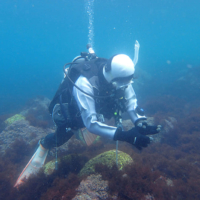* Japanese name: Kiriuji gaganbo
* Scientific name: Tipula aino
* Description: Crane flies are slender insects with light-brown bodies, a black rim around the wings and long legs that dangle beneath them when they fly. This gives them their other English name (used by children): daddy longlegs. Crane flies are true flies, which means they only have one pair of wings (unlike, say, dragonflies, which have two pairs). Where the hind wings would be are a pair of pin-shaped "halteres," which act like gyroscopes and help the fly balance itself in the air. The dangling legs easily break off (especially if pulled by a vindictive child). Larvae have soft bodies and move by wriggling like a maggot. Adults are 14-18 mm long.
* Where to find them: Around rice fields, farms and ponds all over Japan. Adults can be seen twice in the year, from March to June and again from September to November. Females lay eggs in soil, and the larvae live underground.
* Food: The larvae have a well-developed head capsule, with strong jaws used to chew up rotten plant matter and the roots of young plants. The adults do not bite. They have soft mouthparts at the end of a beaklike head, which they use for lapping up nectar from flowers.
* Special features: Crane flies are nocturnal and will be attracted to lights at night. They can also often be seen in a swarm. Unlike, say, locust swarms, which form when food is superabundant, crane flies swarm when they want to reproduce. There are few females present in the swarms, but when one does appear, attracted by the large group of males, she is quickly grabbed by a male and whisked away. Mating pairs can sometimes be seen flying around joined at the abdomen.
10 hours ago



















With your current subscription plan you can comment on stories. However, before writing your first comment, please create a display name in the Profile section of your subscriber account page.